J P Morgan and the International Mercantile Marine (IMM)
By 1900, the WSL was doing very well but many of the shipping lines were not. One of the richest men in the world, Mr John Pierpont Morgan wanted to monopolise the shipping trade and began to buy up the lines most affected by the loss of profit: and acquired The American Line, Red Star, Dominion, Atlantic Transport and Leyland.
By 1902, the International Mercantile Marine (IMM) carried 64,738 passengers, a total influenced by high immigration to the United States. The IMM signed a partnership with the two most important German shipping companies, Norddeutscher Lloyd and HAPAG. Together they carried a total of 66,838 passengers. Morgan wanted their trade and subsequently, The German-Morgan Agreement was signed in New York on 20 February 1902.
Morgan wanted the WSL under his belt and offered the WSL shareholders 10 times as much as the WSL earned in 1900. The majority (75%) wanted to accept this and the last Annual General Meeting of the Oceanic Steam Navigation Company was held on 17 May 1902. Ismay was retained as Managing Director and Chairman and on 25 May, the agreement was signed between Morgan and the WSL. The IMM owned the WSL.
On 1 October 1902, following the earlier purchase of the lines, JP Morgan & Co announced the formation of the IMM). IMM was the holding company that controlled subsidiary companies (the lines). The ships continued to sail under their own house and national flags.
The “Big Four”
The WSL had planned to build the Oceanic’s sister, Olympic, but this plan was scrapped once resources were given to a new project: The “Big Four.”
These were:
At the time of their launch all the ships (except Adriatic) were the largest ships in the world.
The WSL envisaged building ships bigger than the Great Eastern. Each would have gross tonnage in excess of 20,000 tons and would not be built for speed – but luxury. Thomas Ismay ordered the first ship, the Celtic shortly before he died in 1899. The Celtic and Cedric would be smaller than the Baltic and the Adriatic. They would be steam driven, have two propellers and could maintain an average speed of 16 knots. They would each have two funnels and four masts to support the wireless telephone systems.
Luxury was certainly an apt word to describe the ships. Such luxury at sea had never been seen before. There were many features but just to name a few; a glass roof on the dining room, lounge with the reading and writing room with books, large windows, a covered promenade deck, stained glass windows and Turkish Bath’s.
RMS Celtic
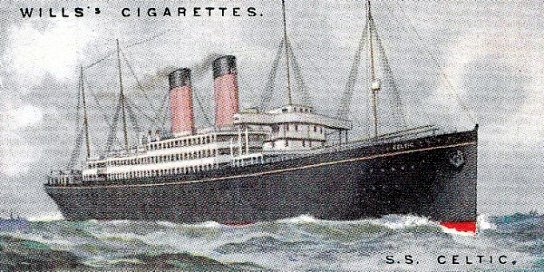
The Celtic was built by Harland and Wolff under keel number 335, launched on 4 April 1901 and completed on 11 July 1901. She was 701 feet long with a beam of 75 feet and had a gross tonnage of 20,904. She was very popular with passengers especially since immigration numbers had increased. She could carry nearly 3000 passengers and 350 crew members. She sailed on her maiden voyage from Liverpool to New York on 26 July 1901.
During the First World War, she was converted to an armed merchant cruiser. In 1916, she was converted to a troopship for transporting troops to Egypt.
In 1917, she hit a mine off the coast of the Isle of Man but did not sink. She was towed to Peel Bay and repaired in Belfast. In 1918, she was torpedoed by a German U-boat but again she did not sink and was repaired.
On 10 December 1928, she became stranded on the Cow and Calf rocks off the coast of Ireland. She suffered serious structural damage and insurance companies wrote her off. She was scrapped in 1933.
RMS Cedric
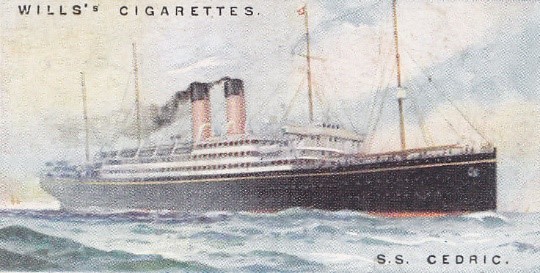
The Cedric was built by Harland and Wolff under keel number 337. Her keel was laid down in 1902, launched on 21 August 1982 and completed on 31 January 1903. She was 700 feet long and the beam of 75.3 feet and had a gross tonnage of 21,035. She could accommodate 2877 passengers: 365 First Class, 160 Second Class and 2352 Third Class and 350 crew. She commenced her maiden voyage from Liverpool to New York on 11 February 1903.
For the first decade of her career she crossed the Atlantic without incident. She was requisitioned for war service after her voyage on 21 October 1914. She was converted to an armed merchant cruiser and later converted to a troopship in 1916, transporting troops to Egypt and then later to America.
In September 1919, the WSL regained control of the Cedric and she returned to Harland and Wolff for a refit. She could accommodate 1599 passengers: 347 First Class, 252 Second Class and 1000 Third Class. She took up service across the Atlantic. Her last cruise was on 5 September 1931, after which she was sold to Thos W Ward for £22,150 in 1932 for scrap.
RMS Baltic
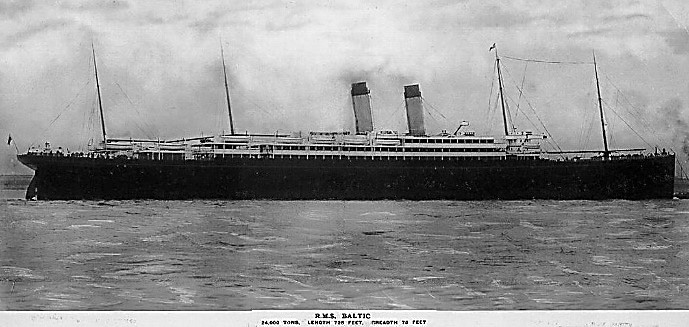
The Baltic (left) was built by Harland and Wolff under keel number 352, launched on 21 November 1903 and completed on 23 June 1904. She was 729 feet long with a beam of 75.6 feet and had a gross tonnage of 23,876. She had two propellers and two cylinder quadruple expansion engines.
She could attain speeds of up to 16 knots. On 29 June 1904 she commenced her maiden voyage, under the command of Captain Edward Smith.
The Baltic, like her sisters, was used during wartime to transport war materials from America to Great Britain. War materials even included gold bullion!
The Baltic was scrapped on 17 February 1933.
RMS Adriatic
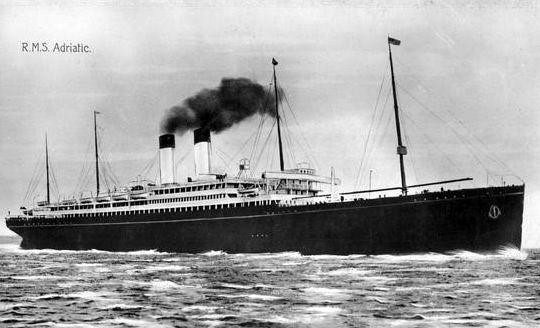
The Adriatic was built by Harland and Wolff under keel number 358. She was launched on 20 September 1906 and completed on 25 April 1907. She was 729 feet long with a beam of 73 feet and had a gross tonnage of 24,541. She had seven decks and propelled by two quadruple expansion steam engines with twin propellers. She could attain an average speed of 17 knots.
The Adriatic could accommodate 2825 passengers: 425 First Class, 500 Second Class and 1900 Third Class. The Adriatic was the first liner to have a Turkish Bath on board.
The Adriatic’s maiden voyage from Liverpool to New York commenced on the 8 May 1907 under Captain Smith. Following her maiden voyage, the WSL took the Adriatic off the Liverpool to New York route and placed her on the Southampton to New York route. The Adriatic was the first liner to use the new dock at Southampton which was called the White Star Dock.
On 4 November 1909, whilst under the command of Captain Smith she ran aground on a sandbank at the south edge of the Ambrose Channel and could not move for several hours.
She returned to the Liverpool to New York service when the Olympic took over the route in 1911. Some surviving passengers from the Titanic returned to England on the Adriatic in April 1912, including Joseph Bruce Ismay and Millvina Dean.
Like her sisters, she was required by the Admiralty during the First World War to serve as a troopship but encountered no incidents.
A common problem for shipping lines was that coal, needed to fire the boilers, is very flammable, especially coal dust. Many ships had small or even large fires on board, even the Titanic had one when she set sail. The Adriatic was no exception There was an explosion in one of the coal bunker killing four people on 11 August 1922.
In 1928, she was converted as a “Cabin class” ship. In 1934 she was chartered by the Boy Scouts Girl Guides for a Mediterranean cruise. Numerous mechanical problems kept putting the Adriatic2 out of service costing the company to lose money. When the Cunard Line (Cunard) merged with WSL in 1934, she was scrapped a year later.
An RMS Adriatic2 promotional leaflet circa 1913
The promotional leaflet from the White Star Line outlines the luxury of the “Big Four.”
"Travellers who frequently cross the Atlantic nearly always acquire a preference for a certain ship, admiring it, perhaps with many good qualities, such as steadiness in all weathers, solid comfort, splendid cuisine, pleasant officials and an efficient staff, or any of a dozen other equally good reasons. Every one of the White Star Line’s famous “Big Four” - the favourite mammoth steamers Adriatic, Baltic, Cedric and Celtic – can boast of hosts of such passengers who choose these vessels the journey after journey, knowing that upon them – in any class – will be found exactly the satisfactory service and the perfection of courtesy they have so thoroughly enjoyed before.
The famous “Big Four” are the largest steamers sailing regularly between New York and Liverpool, calling at Queenstown both Eastbound and Westbound. They are of staunch, sturdy build, with graceful, stately lines, and if there is one comment about them had more often than another, it is at these vessels are “so very steady.” The Adriatic and the Baltic are each 720 feet long, the Cedric and the Celtic being 700 feet in length; all were constructed of the same model, and the accommodations are spacious, airy, and attractive throughout.
The public rooms on board these four steamers are all excellently located to ensure comfort and are tastefully decorated and furnished. The First Class Lounge is perhaps the chief indoor gathering place – always excepting the ever popular dining saloon! The cheery surroundings of the lounge make it an ideal spot for cards or conversation for the leisurely after dinner demi-tasse, and, with the ship’s own orchestra of professional musicians discoursing catchy airs in the main foyer of the steamer, just outside the lounge doors, a pleasant sense of camaraderie is certain to be developed among the passengers, although they hail from many corners of the globe.
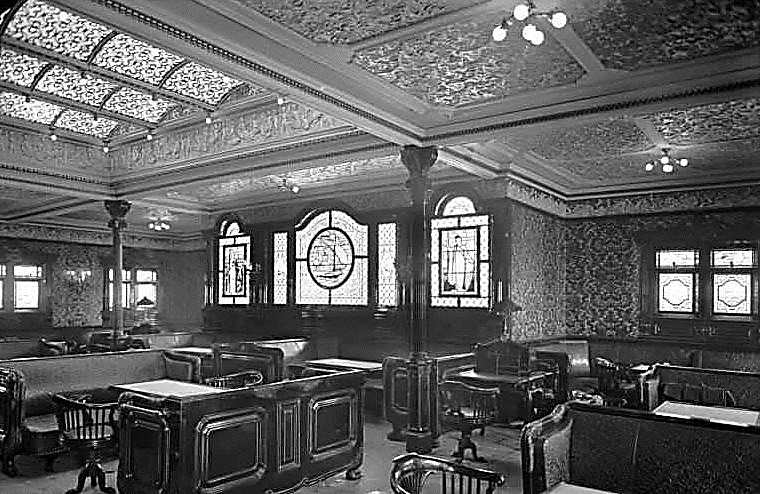
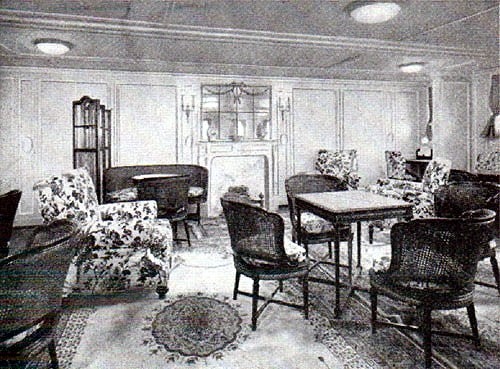
In the drawing room, with its air of cozy comfort, the easy chairs beguile one to while away the passing hours amid these pleasant surroundings. Here is a cosy retreat, with evidences of the best taste and refinement and elegance in all its surroundings. Soft Oriental rugs, often bright in their colouring, a glowing fireplace, beautiful hangings at the windows – all these please the eye and add to the attractiveness of this apartment.
The ships smoking room always holds its own little world of interest for a man at sea. Here the raconteur exchanges quips and stories for the daring adventure tales of the hunter returning home after new conquests. Here also the man of business forgets his cares and rests himself amid the congenial fellowship of other followers of the world’s marts.
There is also on each ship a cosy and well appointed writing room, or combination writing room and drawing room.
On board the Adriatic, the Writing Room is an example of harmony and beauty in design and furnishings, contributing to restful ease. The large windows are characteristic of the writing rooms on White Star ships. The general effect strikes a distinct note of elegance.
The First Class accommodations are situated in the middle third of the ship, the part least subject to motion at sea. They have three passenger deck promenades, that are unusually spacious. Their state rooms are of generous proportions, and are furnished in a style of substantial comfort.
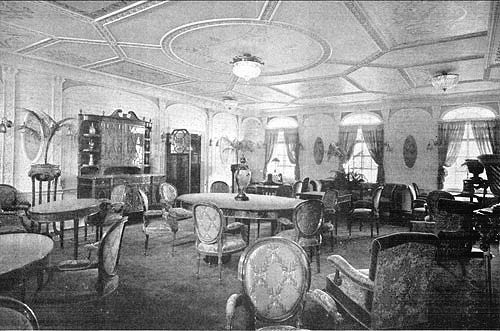
An abiding first impression of the ships is one of great size, solidity and dignity, and of good taste and tone in their general effect. The Travellers good opinion of his ship is strengthened on a voyage by the atmosphere of refinement and quiet on board, by the well chosen menus and excellent cooking, and by the perfection of service in every department.
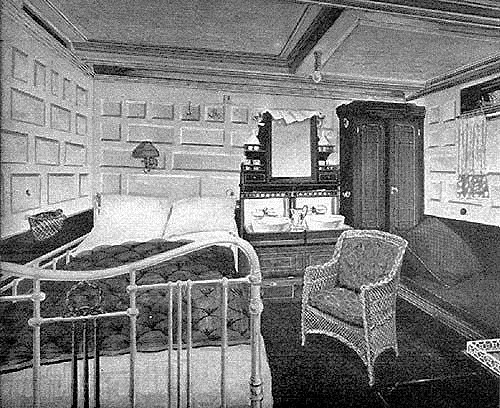
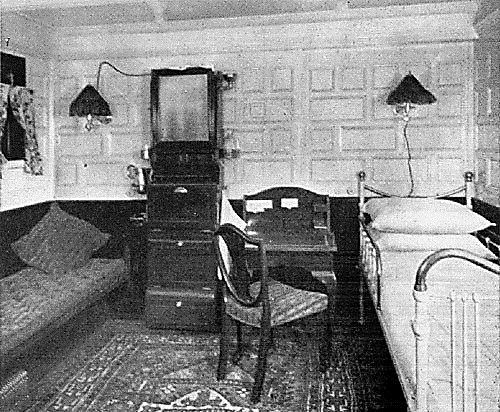
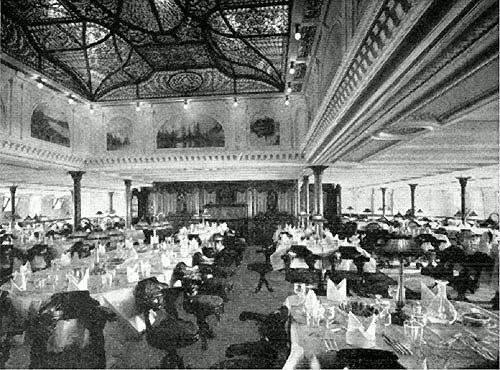
Everything runs like clockwork´ is a comment sometimes heard from appreciative passengers – a tribute to the efficiency of White Star standards, maintained through a half century of successful catering to steamship travellers.
Amusements on the ships are a little less stressed, perhaps, than on the fashionable expressed liners, but they are not lacking. Each ship carries a well – chosen orchestra, which gives daily concerts, and also plays the dancing. Games of various kinds are played in the lounge and smoking room, and there is a generous deck space for outdoor sports.
Each ship has a carefully selected library, and carries the leading current periodicals, both American and European.
The ships of the “Big Four” carry First, Second and Third Class passengers. The Second Class cabin accommodations are spacious and comfortable, and are popular with travellers who are gratified to find that in this Class they get much in return for moderate rates.
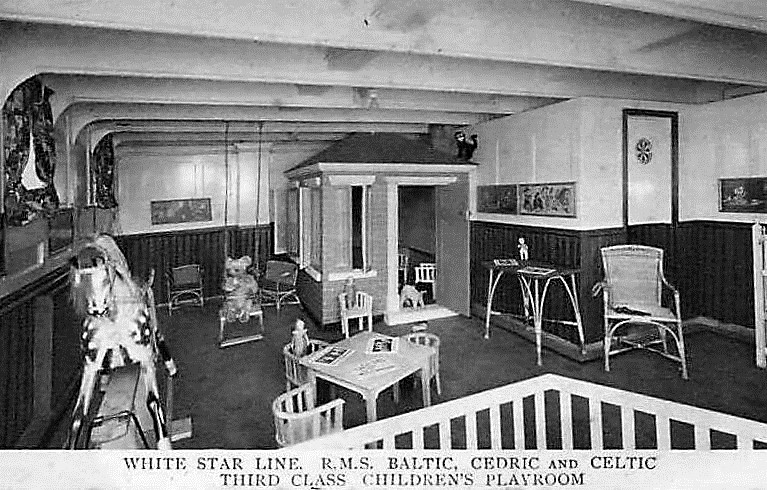
While not driven at the speed of the express steamers plying to Cherbourg and Southampton, the ships of the “Big Four” have abundant power for reliable, steady performance, which enables them to complete their voyages with the regularity of through trains on a railroad.
Passengers by this route are landed at Queenstown by tender and at Liverpool directly at the Riverside landing stage, from which special boat trains depart for London directly after the arrival of each ship. The running time to London is about four hours. Frequent express trains also depart from Liverpool the various tourist centres, the English Lake District, the Shakespeare country and the Welsh mountains being within easy reach.
Two Americans planning a tour of places of scenic and historic interest in Great Britain, the White Star Line’s “Big Four” ships cannot be too highly recommended.”
